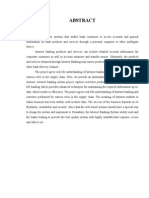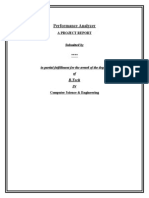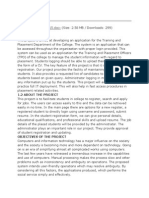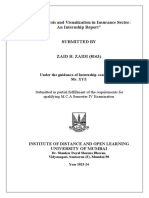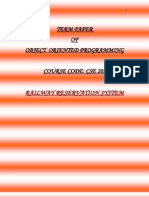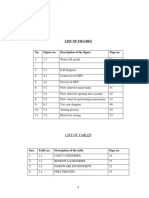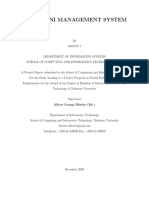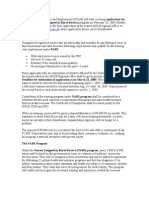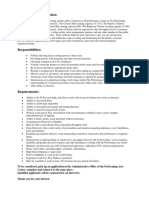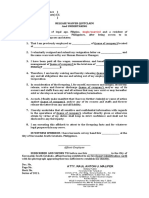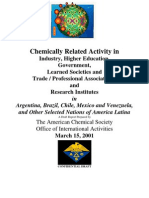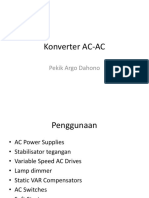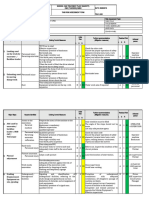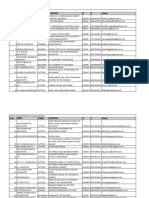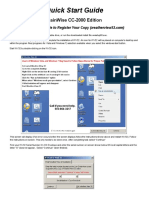Project Guidelines
Type of Projects
1. Application Development
The students are advised to choose a project that involves window-based development, web-based
development, mobile-based development, projects based on machine learning. Analysis and
interpretation of any company specific data is not permitted.
2. Embedded Systems / IoT
A project should be developed and implemented for application specific system after thorough
investigation of the latest development in the field of electronics or communication to facilitate their
efficient operation. The Real Time Operating System (RTOS) or open source platform can be used to
develop embedded applications such as Robotics, Microcontroller / Microprocessor based projects etc.
An IOT project can be used to design products for reliability and security using simple electronics
concepts and integrating with a cloud platform to get the data real-time and make some operational
analysis. It has to use efficient algorithms for strong authentication and security protocols and disable
non-essential services.
Few examples of IoT applications
Smart home, Health care applications, Smart waste management, Activity Tracker etc.
3. ETL Projects
Extract, transform, load (ETL) is the process of integrating the data from one or more sources. It is
expected from the student that he should demonstrate the entire ETL process with reference to any
domain like finance, banking, insurance, retail etc.
Data extraction consists of extracting the data from homogeneous or heterogeneous sources and
transforming it into a proper format using data cleansing. The data can be finally loaded into a final target
database such as operational data base, a data mart or data warehouse. This data can be further used
for the purpose of querying and analyzing.
4. Research Projects
The research project will be able to demonstrate the skills of working scientifically, and through the
project the students will able to understand how to do a literature review, and how to appraise the
literature to address questions. To explore an area of interest (develop some expertise and a deeper
understanding of a topic). Understand the tools to critically and thoughtfully appraise problems which
are faced every day; to learn communicate scientific research in verbal presentations and written form.
As an example, the students can identify any problem, by observation or through survey to understand
the problem in depth and propose the solution by applying the research methodology.
� Project Guidelines: Index
1. Application Development Project
Chapter No Details
1 Introduction
1.1 Company Profile / Institute Profile / Client Profile
1.2 Abstract
1.3 Existing System and Need for System
1.4 Scope of System
1.5 Operating Environment - Hardware and Software
Brief Description of Technology Used
1.6.1 Operating systems used (Windows or Unix)
1.6
1.6.2 RDBMS/No Sql used to build database (mysql/ oracle, Teradata,
etc.)
2 Proposed System
2.1 Study of Similar Systems ( If required research paper can be included)
2.2 Feasibility Study
2.3 Objectives of Proposed System
2.4 Users of System
3 Analysis and Design
3.1 System Requirements (Functional and Non-Functional requirements)
3.2 Entity Relationship Diagram (ERD)
3.3 Table Structure
3.4 Use Case Diagrams
3.5 Class Diagram
3.6 Activity Diagram
3.7 Deployment Diagram
3.8 Module Hierarchy Diagram
Sample Input and Output Screens (Screens must have valid data. All
3.9
reports must have at-least 5 valid records.)
4 Coding
4.1 Algorithms
4.2 Code snippets
5 Testing
5.1 Test Strategy
5.2 Unit Test Plan
� 5.3 Acceptance Test Plan
5.4 Test Case / Test Script
5.5 Defect report / Test Log
6 Limitations of Proposed System
7 Proposed Enhancements
8 Conclusion
9 Bibliography
10 Publication / Competition certificates
11 Appendix – Cost sheet , Data sheet
User Manual (All screens with proper description/purpose Details
12
about validations related to data to be entered.)
2. Embedded Systems / IoT Project
Chapter No Details
1 Introduction
1.1 Company Profile / Institute Profile / Client Profile
1.2 Abstract
1.3 Existing System and Need for System
1.4 Scope of System
1.5 Operating Environment - Hardware and Software
Brief Description of Technology Used
1.6 1.6.1 Operating systems used (Windows or Unix)
1.6.2 Database (if applicable)
2 Proposed System
2.1 Study of Similar Systems ( If required research paper can be included)
2.2 Feasibility Study
2.3 Objectives of Proposed System
2.4 Users of System
3 Analysis and Design
3.1 Technical requirements – H/W , S/W
3.2 System Architecture / Block Diagram
3.3 System Hardware Details
3.4 Pin Diagrams
3.5 Interface diagrams
3.6 Design Sequence
3.7 System Software Details
3.8 Process / System Flow chart
4 Coding
4.1 Algorithms
4.2 Code snippets (if applicable)
5 Testing
� 5.1 Results & reports
5.2 Test cases
5.3 Acceptance Testing
5.4 Test reports in IEEE format
6 Limitations of Proposed System
7 Proposed Enhancements
8 Conclusion
9 Bibliography
10 Publication / Competition certificates
11 Appendix – Cost sheet , Data sheet
User Manual (All screens with proper description/purpose Details
12
about validations related to data to be entered.)
3. ETL Projects
Chapter No Details
1 Introduction
1.1 Company Profile / Institute Profile / Client Profile
Existing System functionality (Source System for which the ANALYTICS is
1.2
being developed)
Business process understanding and specifications
1.3.1 Business Requirement Specifications:
1.3.1. 1 The o/p from BR Analysis are BRS Business Requirement
Specifications (Business specific Rules to be mentioned here from
analysis point of view)
1.3.1.2 Identify the dimensions, required attributes, measures, filter
1.3 conditions, adjustments for KPIs going to be used in the Target system
and its availability in the Source System. If any gaps suggest remediation
of gaps
1.3.2 Business Rules Collection
1.3.3 Identify the Key Performance Indicator (specified by
1.3.4 Establish the User Acceptance Criteria
client)
1.4 Scope of the project
Operating Environment - Hardware & Software, Description of Tools /
Technology to be used in the Target system
1.5.1.1 Operating systems used (Windows or Unix)
1.5.1.2 RDBMS/NoSql used to build database (mysql/ oracle, Teradata,
1.5 etc.)
1.5.1.3 ETL tools used (Talend/Informatica, Datastage etc)
1.5.1.4 OLAP/ Data mining/ machine learning/ analytics tools used
(Python/ Cognos, BO, etc.)
1.5.1.5 Data visualization tools (power BI / Tableau)
2 Proposed System
Creating multiple ETL strategies - Specifying metadata details,
2.1
identifying heterogeneous architectures, processes for I/O only for ETL,
� scrapping , identifying the volatilities in the channels , designing
strategies in the context of the business and existing ERP
Comparing them in the context of selected business system (as per the
2.2
business requirements)
2.3 Suggesting optimum solution (process)
3 Analysis and Design
3.1 Use Case Diagram
3.2 Activity diagram to demonstrate Process flow (execution of ETL process)
Design of Target system (Elaborate the tiers of DW architecture in the
3.3
Target System)
3.4 Database schema / Table specifications of Target system
3.5 Details of Source & Targets of mapping in the database
3.6 Details of Load (Full/Incremental etc.)
3.7 Design of ETL schema/strategy
Design of strategy for Visualization
4.1.1 Visualizations in support of comparison of performance of various
4 4.1
ETL strategies
4.1.2 Data visualization using different techniques (if any)
5 Drawbacks and Limitations Proposed Enhancements
6 Conclusion
4. Research Projects
Research projects especially are designed to gain knowledge about some specified area and the
deliverable is that knowledge gained, usually encapsulated in some form of report.
Students are expected to contribute something new to academic or practical knowledge in their research
area—something original that is more than the accepted knowledge.
Completing a Research Project as part of your coursework is an opportunity to:
• learn to read and interpret other people’s research critically by doing your own. This gives you
an insight into the effects of practical difficulties and theoretical debates on published research
• develop and apply the knowledge that you have learnt in 4 semesters of your curriculum.
• submit a paper for peer-reviewed publication. (If successful, this will give a boost to your c.v.) If
you wish to enroll in a research degree such as PhD, a research project as part of your coursework
will assist the committee evaluating your application in assessing whether you are ready to do
independent research.
Research Index
1. Title page
2. Acknowledgements
You should acknowledge the assistance given to you by your supervisors, and any other person or
organization that has helped you in the planning, conduct, analysis or reporting of your project.
�3. Abstract
This is a synopsis of your study question, aims and objectives, background literature, methods, results,
key conclusions and recommendations. This should be 250–300 words long and should be very clear and
easy to follow.
4. Introduction
In this section of your report you introduce the subject, provide the background to the topic or problem,
outline the study question (or problem or study hypothesis), and outline the aims and objectives of your
study.
5. Literature review
This is a review of the literature on the topic or problem you are studying. It should include a review of
any other studies or projects similar or relevant to yours, and perhaps a review of the literature on the
method you have chosen if your project tests a new method of research or analysis.
6. Methods
This section includes the methodology of your research. It will cover such issues as:
In case of Computer Management Research :
• Study design
• Study population, sampling frame and numbers, sampling method
• survey design
• survey or data collection instruments
• protocol for obtaining data
• ethical issues and how they are addressed
• information letters, consent forms
• data management and analysis methods
• statistical analysis and tests
• In case of Computer Science Research:
• Study design
• System Architecture
• Implementation
o Experimental Implementation
o Simulation
• Data management and analysis methods
• Analysis and testing
7. Results
In this section you present the results of your research. Tables, figures and graphs are an excellent means
of presenting this sort of information. All tables, figures and graphs, should be numbered consecutively
throughout the whole report, and labelled with a clear and concise descriptive title.
�8. Discussion
In this section you interpret your results and discuss their implications, with reference to other published
research. Any limitations in your research methodology should also be referred to here. Examiners
expect you to acknowledge these limitations as an integral part of your evaluation of your project.
9. Conclusion
This section summarizes the key results and the conclusions that you can draw from these results. It also
needs to reflect what your initial project aims and objectives were.
10. Recommendations
It is good research practice to make recommendations or to suggest directions for further research or
actions as a result of your project findings.
11. References
This is a list of all the references and sources you used in your literature review, methodology and
discussion. This includes books, journal articles, abstracts, conference and symposium papers, media
articles, and any form of published literature or comment.
12. Appendices
This section may contain copies of any questionnaires if any or evaluation instruments used covering
letters, participant information and ethics approvals, or additional explanations.
�5. Data Science Projects
1. Intro to Projects – Overview, phases, tools.
2. Data Collection & Prep – Sourcing, cleaning, feature selection.
3. EDA – Stats, visualizations, correlation, outliers.
4. Model Building – Algorithms, training, validation.
5. Advanced ML – Ensembles, deep learning, tuning.
6. Project Execution – Case studies, challenges.
7. Deployment & Monitoring – Techniques, tracking.
8. Documentation – Reporting, storytelling.
9. Ethics & Best Practices – Privacy, fairness, reproducibility.














